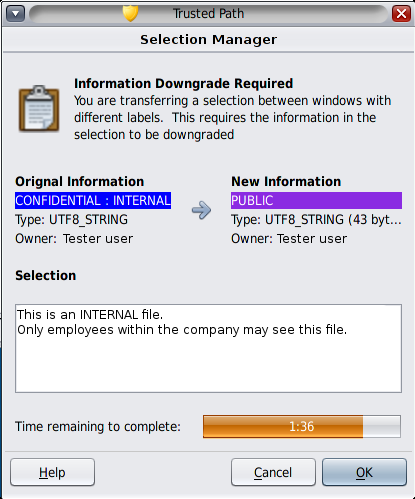| Skip Navigation Links | |
| Exit Print View | |

|
Trusted Extensions Configuration and Administration Oracle Solaris 11.1 Information Library |
| Skip Navigation Links | |
| Exit Print View | |

|
Trusted Extensions Configuration and Administration Oracle Solaris 11.1 Information Library |
Part I Initial Configuration of Trusted Extensions
1. Security Planning for Trusted Extensions
2. Configuration Roadmap for Trusted Extensions
3. Adding the Trusted Extensions Feature to Oracle Solaris (Tasks)
4. Configuring Trusted Extensions (Tasks)
5. Configuring LDAP for Trusted Extensions (Tasks)
Part II Administration of Trusted Extensions
6. Trusted Extensions Administration Concepts
7. Trusted Extensions Administration Tools
8. Security Requirements on a Trusted Extensions System (Overview)
Configurable Security Features
Role Creation in Trusted Extensions
Role Assumption in Trusted Extensions
Trusted Extensions Interfaces for Configuring Security Features
Extension of Oracle Solaris Security Features by Trusted Extensions
Unique Trusted Extensions Security Features
Security Requirements Enforcement
Users and Security Requirements
Group Administration Practices
9. Performing Common Tasks in Trusted Extensions
10. Users, Rights, and Roles in Trusted Extensions (Overview)
11. Managing Users, Rights, and Roles in Trusted Extensions (Tasks)
12. Remote Administration in Trusted Extensions (Tasks)
13. Managing Zones in Trusted Extensions
14. Managing and Mounting Files in Trusted Extensions
15. Trusted Networking (Overview)
16. Managing Networks in Trusted Extensions (Tasks)
17. Trusted Extensions and LDAP (Overview)
18. Multilevel Mail in Trusted Extensions (Overview)
19. Managing Labeled Printing (Tasks)
20. Devices in Trusted Extensions (Overview)
21. Managing Devices for Trusted Extensions (Tasks)
22. Trusted Extensions Auditing (Overview)
23. Software Management in Trusted Extensions
Creating and Managing a Security Policy
Site Security Policy and Trusted Extensions
Computer Security Recommendations
Physical Security Recommendations
Personnel Security Recommendations
Additional Security References
B. Configuration Checklist for Trusted Extensions
Checklist for Configuring Trusted Extensions
C. Quick Reference to Trusted Extensions Administration
Administrative Interfaces in Trusted Extensions
Oracle Solaris Interfaces Extended by Trusted Extensions
Tighter Security Defaults in Trusted Extensions
Limited Options in Trusted Extensions
D. List of Trusted Extensions Man Pages
Trusted Extensions Man Pages in Alphabetical Order
Oracle Solaris Man Pages That Are Modified by Trusted Extensions
By default, regular users can perform cut-and-paste, copy-and-paste, and drag-and-drop operations on both files and selections. The source and target must be at the same label.
To change the label of files, or the label of information within files requires authorization. When users are authorized to change the security level of data, the Selection Manager application mediates the transfer.
The /usr/share/gnome/sel_config file controls file relabeling actions, and the cutting and copying of information to a different label. For more information, see sel_config File and the sel_config(4) man page.
The /usr/bin/tsoljdsselmgr application controls drag-and-drop operations between windows. As the following tables illustrate, the relabeling of a selection is more restrictive than the relabeling of a file.
The following table summarizes the rules for file relabeling. The rules cover cut-and-paste, copy-and-paste, and drag-and-drop operations.
Table 8-1 Conditions for Moving Files to a New Label
|
Different rules apply to selections within a window or file. Drag-and-drop of selections always requires equality of labels and ownership. Drag-and-drop between windows is mediated by the Selection Manager application, not by the sel_config file.
The rules for changing the label of selections are summarized in the following table.
Table 8-2 Conditions for Moving Selections to a New Label
|
Trusted Extensions provides a Selection Manager to mediate label changes. This dialog box appears when an authorized user attempts to change the label of a file or selection. The user has 120 seconds to confirm the operation. To change the security level of data without this window requires the solaris.label.win.noview authorization, in addition to the relabeling authorizations. The following illustration shows a two-line selection in the window.

By default, the Selection Manager displays whenever data is being transferred to a different label. If a selection requires several transfer decisions, the automatic reply mechanism provides a way to reply once to the several transfers. For more information, see the sel_config(4) man page and the following section.
The /usr/share/gnome/sel_config file is checked to determine the behavior of the Selection Manager when an operation would upgrade or downgrade a label.
The sel_config file defines the following:
A list of selection types to which automatic replies are given
Whether certain types of operations can be automatically confirmed
Whether a Selection Manager dialog box is displayed